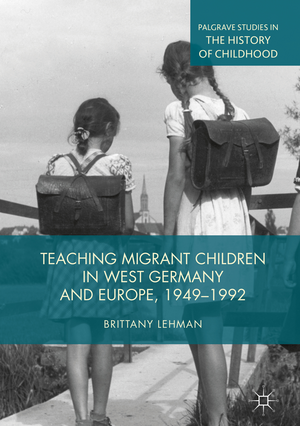Teaching Migrant Children in West Germany and Europe, 1949–1992: Palgrave Studies in the History of Childhood
Autor Brittany Lehmanen Limba Engleză Hardback – 11 dec 2018
Din seria Palgrave Studies in the History of Childhood
- 9%
 Preț: 764.97 lei
Preț: 764.97 lei - 20%
 Preț: 690.61 lei
Preț: 690.61 lei - 20%
 Preț: 754.25 lei
Preț: 754.25 lei - 15%
 Preț: 646.62 lei
Preț: 646.62 lei -
 Preț: 389.70 lei
Preț: 389.70 lei -
 Preț: 395.85 lei
Preț: 395.85 lei -
 Preț: 391.61 lei
Preț: 391.61 lei - 15%
 Preț: 642.83 lei
Preț: 642.83 lei -
 Preț: 386.81 lei
Preț: 386.81 lei -
 Preț: 391.61 lei
Preț: 391.61 lei -
 Preț: 388.13 lei
Preț: 388.13 lei -
 Preț: 385.84 lei
Preț: 385.84 lei -
 Preț: 390.84 lei
Preț: 390.84 lei - 15%
 Preț: 585.08 lei
Preț: 585.08 lei - 18%
 Preț: 950.84 lei
Preț: 950.84 lei - 15%
 Preț: 650.55 lei
Preț: 650.55 lei - 15%
 Preț: 588.50 lei
Preț: 588.50 lei -
 Preț: 223.78 lei
Preț: 223.78 lei -
 Preț: 196.46 lei
Preț: 196.46 lei - 15%
 Preț: 531.26 lei
Preț: 531.26 lei - 18%
 Preț: 901.26 lei
Preț: 901.26 lei -
 Preț: 382.18 lei
Preț: 382.18 lei - 18%
 Preț: 785.11 lei
Preț: 785.11 lei - 18%
 Preț: 779.26 lei
Preț: 779.26 lei -
 Preț: 355.13 lei
Preț: 355.13 lei - 18%
 Preț: 784.48 lei
Preț: 784.48 lei
Preț: 501.39 lei
Preț vechi: 589.87 lei
-15% Nou
Puncte Express: 752
Preț estimativ în valută:
95.94€ • 100.38$ • 79.70£
95.94€ • 100.38$ • 79.70£
Carte tipărită la comandă
Livrare economică 02-16 aprilie
Preluare comenzi: 021 569.72.76
Specificații
ISBN-13: 9783319977270
ISBN-10: 331997727X
Pagini: 260
Ilustrații: XI, 259 p. 6 illus.
Dimensiuni: 148 x 210 mm
Greutate: 0.48 kg
Ediția:1st ed. 2019
Editura: Springer International Publishing
Colecția Palgrave Macmillan
Seria Palgrave Studies in the History of Childhood
Locul publicării:Cham, Switzerland
ISBN-10: 331997727X
Pagini: 260
Ilustrații: XI, 259 p. 6 illus.
Dimensiuni: 148 x 210 mm
Greutate: 0.48 kg
Ediția:1st ed. 2019
Editura: Springer International Publishing
Colecția Palgrave Macmillan
Seria Palgrave Studies in the History of Childhood
Locul publicării:Cham, Switzerland
Cuprins
Chapter 1: Introduction.- Chapter 2. Establishing the Right to Education for Children of Refugees (1949–1955).- Chapter 3: Defining the Right to Education for European Citizens (1955–1966).- Chapter 4: Teaching National Identity to “Guest Worker Children” (1962–1971).- Chapter 5: Equal Opportunities for West German Foreign Residents (1968–1977).- Chapter 6: More of a Right to Education for German Citizens (1976–1985).- Chapter 7: The Right to Education for Asylum Seekers and Ethnic Germans (1985–1992).- Chapter 8: Conclusion.
Notă biografică
Brittany Lehman is Visiting Assistant Professor at the College of Charleston, USA. She is a migration historian focused on Europe and the Middle East. Her current research project focuses on the Federal Republic of Germany’s involvement in decolonization in North Africa and the Middle East as well as the development of humanitarian organizations like Germany Amnesty International.
Textul de pe ultima copertă
This book examines the right to education for migrant children in Europe between 1949 and 1992. Using West Germany as a case study to explore European trends, the book analyzes how the Council of Europe and European Community’s ideological goals were implemented for specific national groups. The book starts with education for displaced persons and exiles in the 1950s, then compares schooling for Italian, Greek, and Turkish labor migrants, then circles back to asylum seekers and returning ethnic Germans. For each group, the state entries involved tried to balance equal education opportunities with the right to personhood, an effort which became particularly convoluted due to implicit biases. When the European Union was founded in 1993, children’s access to education depended on a complicated mix of legal status and perception of cultural compatibility. Despite claims that all children should have equal opportunities, children’s access was limited by citizenship and ethnic identity.
Caracteristici
Examines the contest over children’s identity, using West Germany as a case study to understand the connection between nation, state, and citizen Demonstrates the importance of citizenship status and legal categorisation for different minority group's lived experience and rights Builds on education research, highlighting the connections between schools and learned ethnicity
